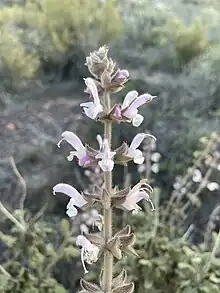Salvia disermas
Salvia disermas (dassie sage) is a herbaceous perennial shrub native to South Africa (the Cape Provinces, the Free State and the Northern Provinces),[1] found in streambeds, moist forest, grassland, and disturbed ground. It was originally specified as rugosa, but was changed to disermas. It grows throughout west Africa, with its greatest concentration in South Africa, where it is used medicinally as a tea, and as a lotion for treating sores.
| Salvia disermas | |
|---|---|
 | |
| Scientific classification | |
| Kingdom: | Plantae |
| Clade: | Tracheophytes |
| Clade: | Angiosperms |
| Clade: | Eudicots |
| Clade: | Asterids |
| Order: | Lamiales |
| Family: | Lamiaceae |
| Genus: | Salvia |
| Species: | S. disermas |
| Binomial name | |
| Salvia disermas | |
Salvia disermas is an evergreen that reaches about 2 ft (0.61 m) in height and width, with numerous stems growing from the rootstock, each with multiple inflorescences that curve upward. The icy white to pale mauve flowers are less than 1.5 in (3.8 cm) long and held in a small green calyx. The individual flowers are not showy, but the plant blooms profusely, and is rarely out of bloom. The long narrow leaves are pale apple-green with a fragrance similar to hay.[2]
Notes
- "Salvia disermas". World Checklist of Selected Plant Families. Royal Botanic Gardens, Kew. Retrieved 2015-08-12.
- Clebsch, Betsy; Barner, Carol D. (2003). The New Book of Salvias. Timber Press. p. 102. ISBN 978-0-88192-560-9.